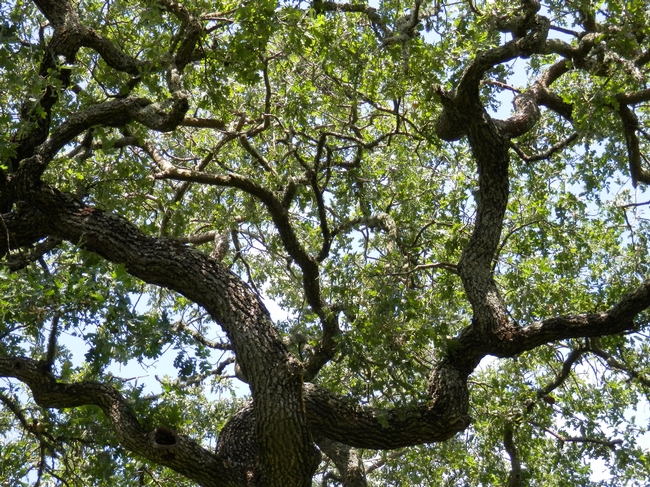
Oak trees typically grow in woodlands, in conditions ranging from shallow soils with little moisture to the deep, fertile soils of the alluvial valley floors. These trees are as diverse in appearance as the conditions they grow in, ranging from 15 to150 feet tall. They differ in shape, color, leaf texture and type of acorns, and whether they are deciduous, evergreen to semi-evergreen.
If you are preparing to plant an oak tree (or an acorn), you need to know the soil type, sun exposure and available water at the potential planting site. The valley oak (Quercuslobata) flourishes in the deep, fertile, well-drained soil typical of floodplains and valley floors. The scrub oak (Q. berberidifolia), black oak (Q. kelloggii) and coast live oak (Q. agrifolia) all thrive in Mediterranean-type climates characterized by mild, wet winters and hot, dry summers. These species want no summer water. If you are looking to plant an oak tree in a dry habitat, on shallow, rocky, infertile soil, your best choices would be blue oak(Q. douglasii), canyon live oak (Q. chrysolepis), Oregon oak (Q. garryana), interior oak (Q. wislizenii), or the humble leather oak (Q. durata).
There are many reasons to keep an existing oak tree.They increase your property value, prevent soil erosion, provide shade and shelter for wildlife and are beautiful to boot.
To keep an oak tree healthy, take care to protect the sensitive root system. Roots can extend beyond the tree's drip line by at least one-third of that distance. Do not dig, grade, trench, compact, asphalt, concrete or pave around your oak tree. These activities may fatally damage the root, trunk or crown.
Changing the grade, trenching, mounding or creating a swale may also lead to changing the natural drainage. If a mature oak gets more water than it is accustomed to, it will decline.
Keep thirsty plants and plantings out of the root zone. Irrigation from agriculture plays a big role in the decline of the valley oak. Choose compatible plants to site under and around your oak.
Many California native plants cohabitate happily with oaks. Here are some great resources for suitable plants:
http://www.napavalleycnps.org/
http://www.californiaoaks.org/ExtAssets/CompatiblePlantsUnder&AroundOaks.pdf
http://www.mostlynatives.com/plant-characteristics/under-oaks
http://www.laspilitas.com/groups/oaks/Planting_under_oak_tree.html
The only fertilizer an established oak needs is its own organic leaf litter for mulch. Keep leaf litter in place, just not up against the trunk. Mulching conserves water, helps moderate ground temperature, improves soil structure and increases organic matter.
If you must prune an oak tree, follow the Tree Care Industry Association guidelines, which you can find online. Pruning improperly can lead to wounds that attract insects and promote decay. Poor pruning may also stimulate rapid shoot growth that increases the potential for powdery mildew. It will also compromise the natural beauty of the tree and may make the tree structurally unstable. For the best results, consult a local arborist.
Many organisms have symbiotic relationships with the oak tree. Lichens flourish on oak trees where there is sufficient moisture, taking nothing from the oak. Many creatures find the acorns a carbohydrate-rich and fatty addition to their diet. Acorns are appreciated by deer, squirrels, woodpeckers, livestock and boar. Oak trees also shelter many nesting birds, arboreal salamanders, invertebrates and insects.
The most complicated relationship the oak tree has is with mycorrhizal fungi. These fungi live in and on the roots and extend way beyond the root system. The oak provides carbohydrates (food) for the fungi and brings up deep water that the fungi can't access. In return, the fungi break down minerals and nutrients and make them available to the oak. In addition, they produce chemicals that inhibit bacteria, thus protecting the tree from disease. With some attention, we humans can also be among the organisms that live symbiotically with the oak tree.
Tree Walk: Join the U.C. Master Gardeners of Napa County on Monday, October 5, from 10 a.m. to 11 a.m., for aguided tree walk in Napa's Fuller Park. The walk is free but pre-registration is strongly recommended as space is limited to 20 people. The walk will repeat on Monday, November 2, from 10 a.m. to 11 a.m. Both walks start in Fuller Park at the corner of Oak and Jefferson Streets in Napa.Online registration
Workshop: U. C. Master Gardeners of Napa County will host a workshop on “California Oaks” on Saturday, October 10, from 9:30 a.m. to 11:30 a.m., at the Martha Walker Garden in Skyline Park, 2201 Imola Avenue, Napa. Stroll around Skyline Park and the Martha Walker Garden to view oaks in their native habitat. Discover what grows alongside and underneath oaks. Learn about planting under oak trees in your own garden, how to care for oaks and about Sudden Oak Death and other stresses on oaks. In case of rain, the workshop will move to the University of California Cooperative Extension office,1710Soscol Avenue, Napa.Online registration (credit card only)Mail-in registration (cash or check only)
Master Gardeners are volunteers who help the University of California reach the gardening public with home gardening information. U. C. Master Gardeners of Napa County ( http://ucanr.org/ucmgnapa/) are available to answer gardening questions in person or by phone, Monday, Wednesday and Friday, 9 a.m. to Noon, at the U. C. Cooperative Extension office, 1710 Soscol Avenue, Suite 4, Napa, 707-253-4143, or from outside City of Napa toll-free at 877-279-3065. Or e-mail your garden questions by following the guidelines on our web site. Click on Napa, then on Have Garden Questions? Find us on Facebook under UC Master Gardeners of Napa County.